Refined Landslide Susceptibility Mapping by Integrating the SHAP-CatBoost Model and InSAR Observations: A Case Study of Lishui, Southern China
Abstract
:1. Introduction
2. Study Area and Data Preparation
2.1. Study Area
2.2. Data Preparation
2.2.1. Landslide Dataset
2.2.2. Impact Factor
3. Methodology
3.1. IV-CatBoost
3.1.1. Statistical Analyses
3.1.2. Information Value Method
3.1.3. CatBoost
3.2. SBAS-InSAR
3.3. Integration
3.4. Model Accuracy Evaluation and Feature Importance Analysis
3.4.1. Model Accuracy Evaluation
3.4.2. Feature Importance Analysis
4. Results
4.1. IV-CatBoost Model Results
4.1.1. Impact Factor Correlation Analysis Results
4.1.2. IV-CatBoost Model Non-Landslide Point Selection
4.1.3. Landslide Susceptibility Mapping Using the IV-CatBoost Model
4.2. SBAS-InSAR Results
4.3. IVCI Model Results
5. Discussion
5.1. IVCI Model Verification and Evaluation
5.2. Feature Importance Analysis
5.3. Limitations of the Approach
6. Conclusions
- (1)
- This study employed multi-temporal optical remote sensing images and the IV method to refine the selection of landslide and non-landslide points within traditional machine learning models. This process effectively alleviated the dimensional influence among different features. Due to the removal of dimensionality differences, the data that are fed into the model for IV-based classification result from calculations. Compared to ensemble learning models such as LightGBM and XGBoost, CatBoost autonomously manages categorical features, reducing the complexity of feature preprocessing. Additionally, it is less susceptible to outliers and noise, ensuring a more stable and accurate model.
- (2)
- Using the hyperopt framework for hyperparameter optimization, we constructed the IV-CatBoost model, achieving an RMSE of 0.24, an R2 of 0.77, and an MAE of 0.16, demonstrating a high level of accuracy. In the resulting model, 90.71% of landslide points are located within the VH and H regions, with only 1.06% falling within the VL region, resulting in an AUC value of 0.88.
- (3)
- To make the model interpretable, SHAP values were computed for the features, revealing the ranking of feature importance and their distributions. The results showed that the distance to roads and terrain factors have relatively significant impacts on the model, aligning with optical remote sensing interpretation results and on-site conditions, thus reflecting the model’s accuracy.
- (4)
- This study requires obtaining long-term surface deformation information in the research area to precisely understand the slope conditions. Therefore, DInSAR has limitations, and it is recommended to choose PS-InSAR and SBAS-InSAR, which can capture extended temporal sequences. Given that the research area is hilly, with most regions being mountainous, to ensure accurate computation results, we selected the SBAS-InSAR method for this InSAR calculation to acquire precise surface deformation information in the research area. The SBAS-InSAR results indicate that the majority of the regions exhibit annual deformation between −10.0 mm/y and 10.0 mm/y.
- (5)
- By integrating SBAS-InSAR technology, the existing IV-CatBoost model was augmented with dynamic deformation factors to establish the IVCI model. As a result, 165,784 grids attained enhanced susceptibility classification precision through InSAR-driven refinements, yielding an AUC value of 0.90. Quantitatively, the IVCI model’s accuracy surpasses that of the IV-CatBoost model.
- (6)
- By analyzing the differences between the IV-CatBoost model and the IVCI model, three areas with significant modifications were identified. Validation using optical remote sensing images and SBAS-InSAR results confirmed that these areas are in an unstable state, and the results of the IV-CatBoost model did not align with the ground truth, leading to misclassifications. This illustrates that the introduction of InSAR technology can effectively identify and correct classification errors in the model, further enhancing the accuracy of the susceptibility model.
Supplementary Materials
Author Contributions
Funding
Institutional Review Board Statement
Informed Consent Statement
Data Availability Statement
Acknowledgments
Conflicts of Interest
References
- Brabb, E.E. Innovative approaches to landslide hazard and risk mapping. In Proceedings of the International Landslide Symposium Proceedings, Toronto, ON, Canada, 23–31 August 1985. [Google Scholar]
- Pei, Y.Q.; Qiu, H.J.; Yang, D.D.; Liu, Z.J.; Ma, S.Y.; Li, J.Y.; Cao, M.M.; Wufuer, W. Increasing landslide activity in the Taxkorgan River Basin (eastern Pamirs Plateau, China) driven by climate change. Catena 2023, 223, 106911. [Google Scholar] [CrossRef]
- Zhan, J.W.; Yu, Z.Y.; Lv, Y.; Peng, J.B.; Song, S.Y.; Yao, Z.W. Rockfall Hazard Assessment in the Taihang Grand Canyon Scenic Area Integrating Regional-Scale Identification of Potential Rockfall Sources. Remote Sens. 2022, 14, 3021. [Google Scholar] [CrossRef]
- Jiang, S.H.; Huang, J.S.; Huang, F.M.; Yang, J.H.; Yao, C.; Zhou, C.B. Modelling of spatial variability of soil undrained shear strength by conditional random fields for slope reliability analysis. Appl. Math. Model. 2018, 63, 374–389. [Google Scholar] [CrossRef]
- Kavoura, K.; Sabatakakis, N. Investigating landslide susceptibility procedures in Greece. Landslides 2019, 17, 127–145. [Google Scholar] [CrossRef]
- Marjanović, M.; Kovačević, M.; Bajat, B.; Voženílek, V. Landslide susceptibility assessment using SVM machine learning algorithm. Eng. Geol. 2011, 123, 225–234. [Google Scholar] [CrossRef]
- Thomas, A.V.; Saha, S.; Danumah, J.H.; Raveendran, S.; Prasad, M.K.; Ajin, R.S.; Kuriakose, S.L. Landslide Susceptibility Zonation of Idukki District Using GIS in the Aftermath of 2018 Kerala Floods and Landslides: A Comparison of AHP and Frequency Ratio Methods. J. Geovis. Spat. Anal. 2021, 5, 21. [Google Scholar] [CrossRef]
- Khosravi, K.; Nohani, E.; Maroufinia, E.; Pourghasemi, H.R. A GIS-based flood susceptibility assessment and its mapping in Iran: A comparison between frequency ratio and weights-of-evidence bivariate statistical models with multi-criteria decision-making technique. Nat. Hazards 2016, 83, 947–987. [Google Scholar] [CrossRef]
- Shahabi, H.; Hashim, M.; Ahmad, B.B. Remote sensing and GIS-based landslide susceptibility mapping using frequency ratio, logistic regression, and fuzzy logic methods at the central Zab basin, Iran. Environ. Earth Sci. 2015, 73, 8647–8668. [Google Scholar] [CrossRef]
- Yalcin, A.; Reis, S.; Aydinoglu, A.C.; Yomralioglu, T. A GIS-based comparative study of frequency ratio, analytical hierarchy process, bivariate statistics and logistics regression methods for landslide susceptibility mapping in Trabzon, NE Turkey. Catena 2011, 85, 274–287. [Google Scholar] [CrossRef]
- Tehrany, M.S.; Pradhan, B.; Jebur, M.N. Spatial prediction of flood susceptible areas using rule based decision tree (DT) and a novel ensemble bivariate and multivariate statistical models in GIS. J. Hydrol. 2013, 504, 69–79. [Google Scholar] [CrossRef]
- Hong, H.Y.; Tsangaratos, P.; Ilia, I.; Liu, J.Z.; Zhu, A.X.; Chen, W. Application of fuzzy weight of evidence and data mining techniques in construction of flood susceptibility map of Poyang County, China. Sci. Total Environ. 2018, 625, 575–588. [Google Scholar] [CrossRef] [PubMed]
- Akinci, H.; Yavuz Ozalp, A. Landslide susceptibility mapping and hazard assessment in Artvin (Turkey) using frequency ratio and modified information value model. Acta Geophys. 2021, 69, 725–745. [Google Scholar] [CrossRef]
- Deng, H.; Wu, X.; Zhang, W.; Liu, Y.; Li, W.; Li, X.; Zhou, P.; Zhuo, W. Slope-Unit Scale Landslide Susceptibility Mapping Based on the Random Forest Model in Deep Valley Areas. Remote Sens. 2022, 14, 4245. [Google Scholar] [CrossRef]
- Towfiqul Islam, A.R.M.; Talukdar, S.; Mahato, S.; Kundu, S.; Eibek, K.U.; Pham, Q.B.; Kuriqi, A.; Linh, N.T.T. Flood susceptibility modelling using advanced ensemble machine learning models. Geosci. Front. 2021, 12, 101075. [Google Scholar] [CrossRef]
- Huang, F.; Yin, K.; Huang, J.; Gui, L.; Wang, P. Landslide susceptibility mapping based on self-organizing-map network and extreme learning machine. Eng. Geol. 2017, 223, 11–22. [Google Scholar] [CrossRef]
- Chen, W.; Pourghasemi, H.R.; Kornejady, A.; Zhang, N. Landslide spatial modeling: Introducing new ensembles of ANN, MaxEnt, and SVM machine learning techniques. Geoderma 2017, 305, 314–327. [Google Scholar] [CrossRef]
- Thi Ngo, P.T.; Panahi, M.; Khosravi, K.; Ghorbanzadeh, O.; Kariminejad, N.; Cerda, A.; Lee, S. Evaluation of deep learning algorithms for national scale landslide susceptibility mapping of Iran. Geosci. Front. 2021, 12, 505–519. [Google Scholar] [CrossRef]
- Wang, H.J.; Zhang, L.M.; Luo, H.Y.; He, J.; Cheung, R.W.M. AI-powered landslide susceptibility assessment in Hong Kong. Eng. Geol. 2021, 288, 106103. [Google Scholar] [CrossRef]
- Habumugisha, J.M.; Chen, N.S.; Rahman, M.; Islam, M.M.; Ahmad, H.; Elbeltagi, A.; Sharma, G.; Liza, S.N.; Dewan, A. Landslide Susceptibility Mapping with Deep Learning Algorithms. Sustainability 2022, 14, 1734. [Google Scholar] [CrossRef]
- Huang, W.B.; Ding, M.T.; Li, Z.H.; Yu, J.C.; Ge, D.Q.; Liu, Q.; Yang, J. Landslide susceptibility mapping and dynamic response along the Sichuan-Tibet transportation corridor using deep learning algorithms. Catena 2023, 222, 106866. [Google Scholar] [CrossRef]
- Lv, L.; Chen, T.; Dou, J.; Plaza, A. A hybrid ensemble-based deep-learning framework for landslide susceptibility mapping. Int. J. Appl. Earth Obs. 2022, 108, 102713. [Google Scholar] [CrossRef]
- Wang, Y.; Fang, Z.C.; Hong, H.Y. Comparison of convolutional neural networks for landslide susceptibility mapping in Yanshan County, China. Sci. Total Environ. 2019, 666, 975–993. [Google Scholar] [CrossRef] [PubMed]
- Habibi, A.; Delavar, M.R.; Sadeghian, M.S.; Nazari, B.; Pirasteh, S. A hybrid of ensemble machine learning models with RFE and Boruta wrapper-based algorithms for flash flood susceptibility assessment. Int. J. Appl. Earth Obs. 2023, 122, 103401. [Google Scholar] [CrossRef]
- Sahin, E.K. Implementation of free and open-source semi-automatic feature engineering tool in landslide susceptibility mapping using the machine-learning algorithms RF, SVM, and XGBoost. Stoch. Environ. Res. Risk Assess. 2023, 37, 1067–1092. [Google Scholar] [CrossRef]
- Zhang, H.; Song, Y.; Xu, S.; He, Y.; Li, Z.; Yu, X.; Liang, Y.; Wu, W.; Wang, Y. Combining a class-weighted algorithm and machine learning models in landslide susceptibility mapping: A case study of Wanzhou section of the Three Gorges Reservoir, China. Comput. Geosci. 2022, 158, 104966. [Google Scholar] [CrossRef]
- Pradhan, B.; Dikshit, A.; Lee, S.; Kim, H. An explainable AI (XAI) model for landslide susceptibility modeling. Appl. Soft Comput. 2023, 142, 110324. [Google Scholar] [CrossRef]
- Iban, M.C.; Bilgilioglu, S.S. Snow avalanche susceptibility mapping using novel tree-based machine learning algorithms (XGBoost, NGBoost, and LightGBM) with eXplainable Artificial Intelligence (XAI) approach. Stoch. Environ. Res. Risk Assess. 2023, 37, 2243–2270. [Google Scholar] [CrossRef]
- Meghanadh, D.; Kumar Maurya, V.; Tiwari, A.; Dwivedi, R. A multi-criteria landslide susceptibility mapping using deep multi-layer perceptron network: A case study of Srinagar-Rudraprayag region (India). Adv. Space Res. 2022, 69, 1883–1893. [Google Scholar] [CrossRef]
- Li, G.; Ding, Z.g.; Li, M.f.; Hu, Z.h.; Jia, X.t.; Li, H.; Zeng, T. Bayesian Estimation of Land Deformation Combining Persistent and Distributed Scatterers. Remote Sens. 2022, 14, 3471. [Google Scholar] [CrossRef]
- Amoroso, N.; Cilli, R.; Nitti, D.O.; Nutricato, R.; Iban, M.C.; Maggipinto, T.; Tangaro, S.; Monaco, A.; Bellotti, R. PSI Spatially Constrained Clustering: The Sibari and Metaponto Coastal Plains. Remote Sens. 2023, 15, 2560. [Google Scholar] [CrossRef]
- Chen, J.; Liu, L.; Zhang, T.j.; Cao, B.; Lin, H. Using Persistent Scatterer Interferometry to Map and Quantify Permafrost Thaw Subsidence: A Case Study of Eboling Mountain on the Qinghai-Tibet Plateau. J. Geophys. Res. Earth Surf. 2018, 123, 2663–2676. [Google Scholar] [CrossRef]
- Zhang, H.; Zeng, R.; Zhang, Y.; Zhao, S.; Meng, X.; Li, Y.; Liu, W.; Meng, X.; Yang, Y. Subsidence monitoring and influencing factor analysis of mountain excavation and valley infilling on the Chinese Loess Plateau: A case study of Yan’an New District. Eng. Geol. 2022, 297, 106482. [Google Scholar] [CrossRef]
- Ciampalini, A.; Raspini, F.; Lagomarsino, D.; Catani, F.; Casagli, N. Landslide susceptibility map refinement using PSInSAR data. Remote Sens. Environ. 2016, 184, 302–315. [Google Scholar] [CrossRef]
- Shen, C.Y.; Feng, Z.K.; Xie, C.; Fang, H.R.; Zhao, B.B.; Ou, W.H.; Zhu, Y.; Wang, K.; Li, H.W.; Bai, H.L.; et al. Refinement of Landslide Susceptibility Map Using Persistent Scatterer Interferometry in Areas of Intense Mining Activities in the Karst Region of Southwest China. Remote Sens. 2019, 11, 2821. [Google Scholar] [CrossRef]
- Zhang, G.; Wang, S.Y.; Chen, Z.W.; Liu, Y.T.; Xu, Z.X.; Zhao, R.S. Landslide susceptibility evaluation integrating weight of evidence model and InSAR results, west of Hubei Province, China. Egypt. J. Remote Sens. 2023, 26, 95–106. [Google Scholar] [CrossRef]
- Cao, C.; Zhu, K.X.; Xu, P.H.; Shan, B.; Yang, G.; Song, S.Y. Refined landslide susceptibility analysis based on InSAR technology and UAV multi-source data. J. Clean. Prod. 2022, 368, 133146. [Google Scholar] [CrossRef]
- Wang, Y.M.; Wu, X.L.; Chen, Z.J.; Ren, F.; Feng, L.W.; Du, Q.Y. Optimizing the Predictive Ability of Machine Learning Methods for Landslide Susceptibility Mapping Using SMOTE for Lishui City in Zhejiang Province, China. Int. J. Environ. Res. Public Health 2019, 16, 368. [Google Scholar] [CrossRef]
- Wu, Y.L.; Ke, Y.T.; Chen, Z.; Liang, S.Y.; Zhao, H.L.; Hong, H.Y. Application of alternating decision tree with AdaBoost and bagging ensembles for landslide susceptibility mapping. Catena 2020, 187, 104396. [Google Scholar] [CrossRef]
- Huang, F.M.; Cao, Z.S.; Guo, J.F.; Jiang, S.H.; Li, S.; Guo, Z.Z. Comparisons of heuristic, general statistical and machine learning models for landslide susceptibility prediction and mapping. Catena 2020, 191, 104580. [Google Scholar] [CrossRef]
- Dorogush, A.V.; Gulin, A.; Gusev, G.; Kazeev, N.; Ostroumova, L.; Vorobev, A. Fighting biases with dynamic boosting. arXiv 2017, arXiv:1706.09516. [Google Scholar]
- Wasowski, J.; Bovenga, F. Investigating landslides and unstable slopes with satellite Multi Temporal Interferometry: Current issues and future perspectives. Eng. Geol. 2014, 174, 103–138. [Google Scholar] [CrossRef]
- Zhao, R.; Li, Z.w.; Feng, G.c.; Wang, Q.j.; Hu, J. Monitoring surface deformation over permafrost with an improved SBAS-InSAR algorithm: With emphasis on climatic factors modeling. Remote Sens. Environ. 2016, 184, 276–287. [Google Scholar] [CrossRef]
- Zhu, Z.; Gan, S.; Yuan, X.; Zhang, J. Landslide Susceptibility Mapping with Integrated SBAS-InSAR Technique: A Case Study of Dongchuan District, Yunnan (China). Sensors 2022, 22, 5587. [Google Scholar] [CrossRef] [PubMed]
- Cantarino, I.; Carrion, M.A.; Goerlich, F.; Martinez Ibañez, V. A ROC analysis-based classification method for landslide susceptibility maps. Landslides 2019, 16, 265–282. [Google Scholar] [CrossRef]
- Ekmekcioğlu, Ö.; Koc, K. Explainable step-wise binary classification for the susceptibility assessment of geo-hydrological hazards. Catena 2022, 216, 106379. [Google Scholar] [CrossRef]
- Zhang, J.Y.; Ma, X.L.; Zhang, J.L.; Sun, D.L.; Zhou, X.Z.; Mi, C.L.; Wen, H.J. Insights into geospatial heterogeneity of landslide susceptibility based on the SHAP-XGBoost model. J. Environ. Manag. 2023, 332, 117357. [Google Scholar] [CrossRef]
- Pradhan, S.P.; Siddique, T. Stability assessment of landslide-prone road cut rock slopes in Himalayan terrain: A finite element method based approach. J. Rock. Mech. Geotech. 2020, 12, 59–73. [Google Scholar] [CrossRef]
- Rosi, A.; Tofani, V.; Tanteri, L.; Tacconi Stefanelli, C.; Agostini, A.; Catani, F.; Casagli, N. The new landslide inventory of Tuscany (Italy) updated with PS-InSAR: Geomorphological features and landslide distribution. Landslides 2018, 15, 5–19. [Google Scholar] [CrossRef]
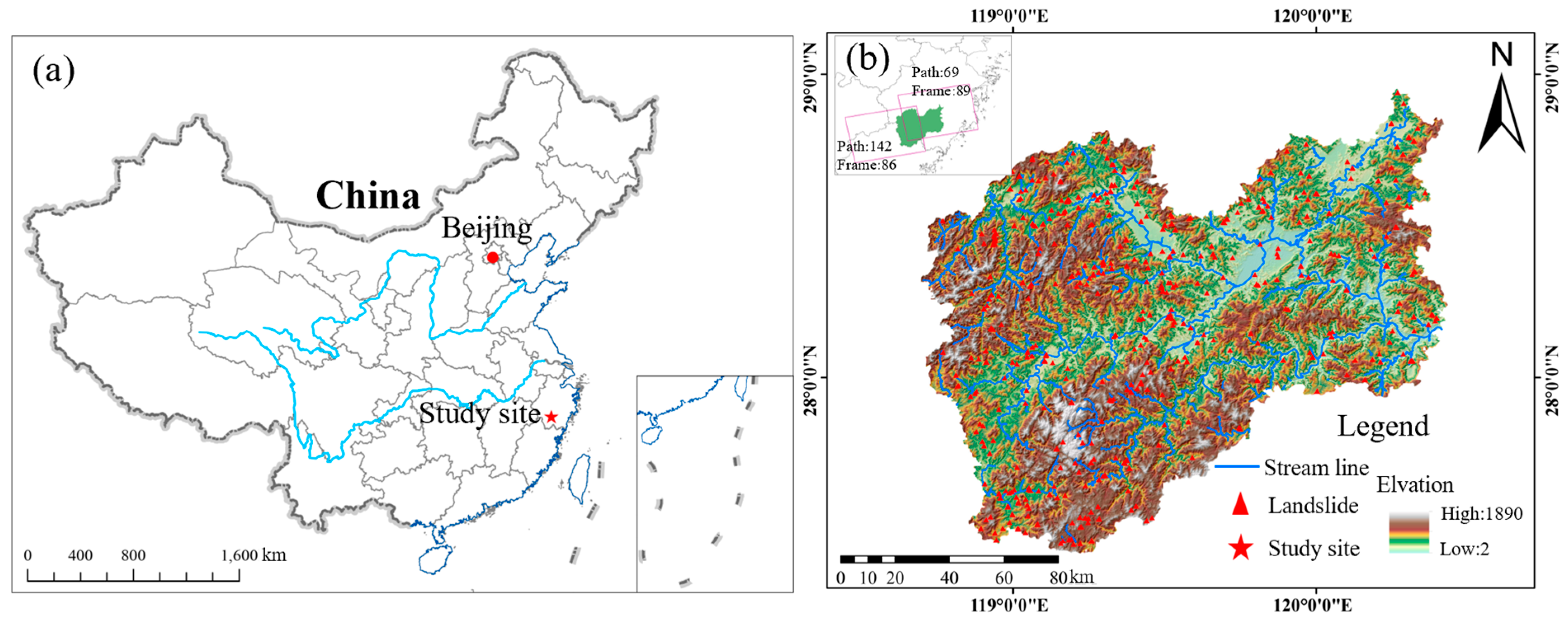
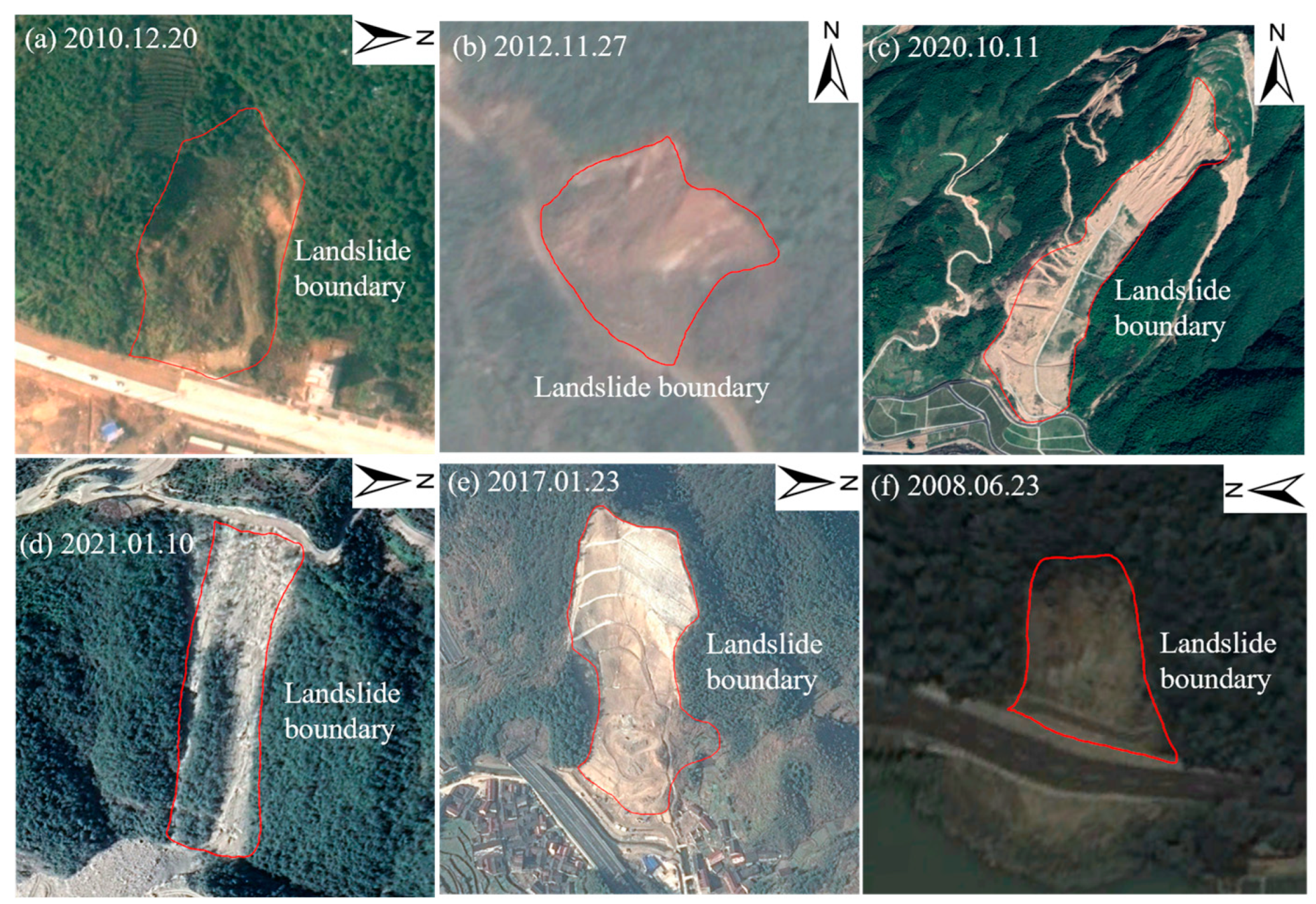
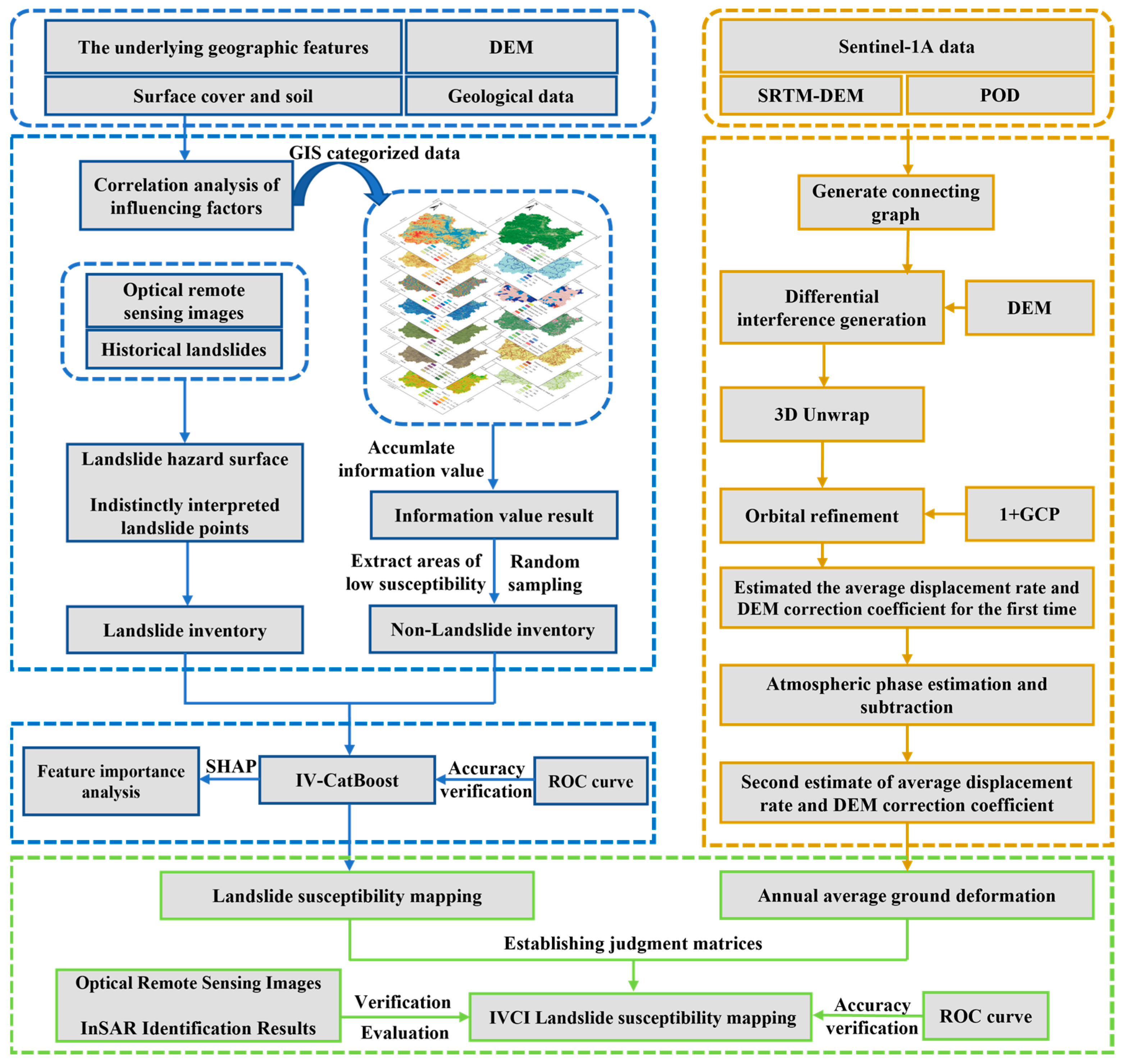



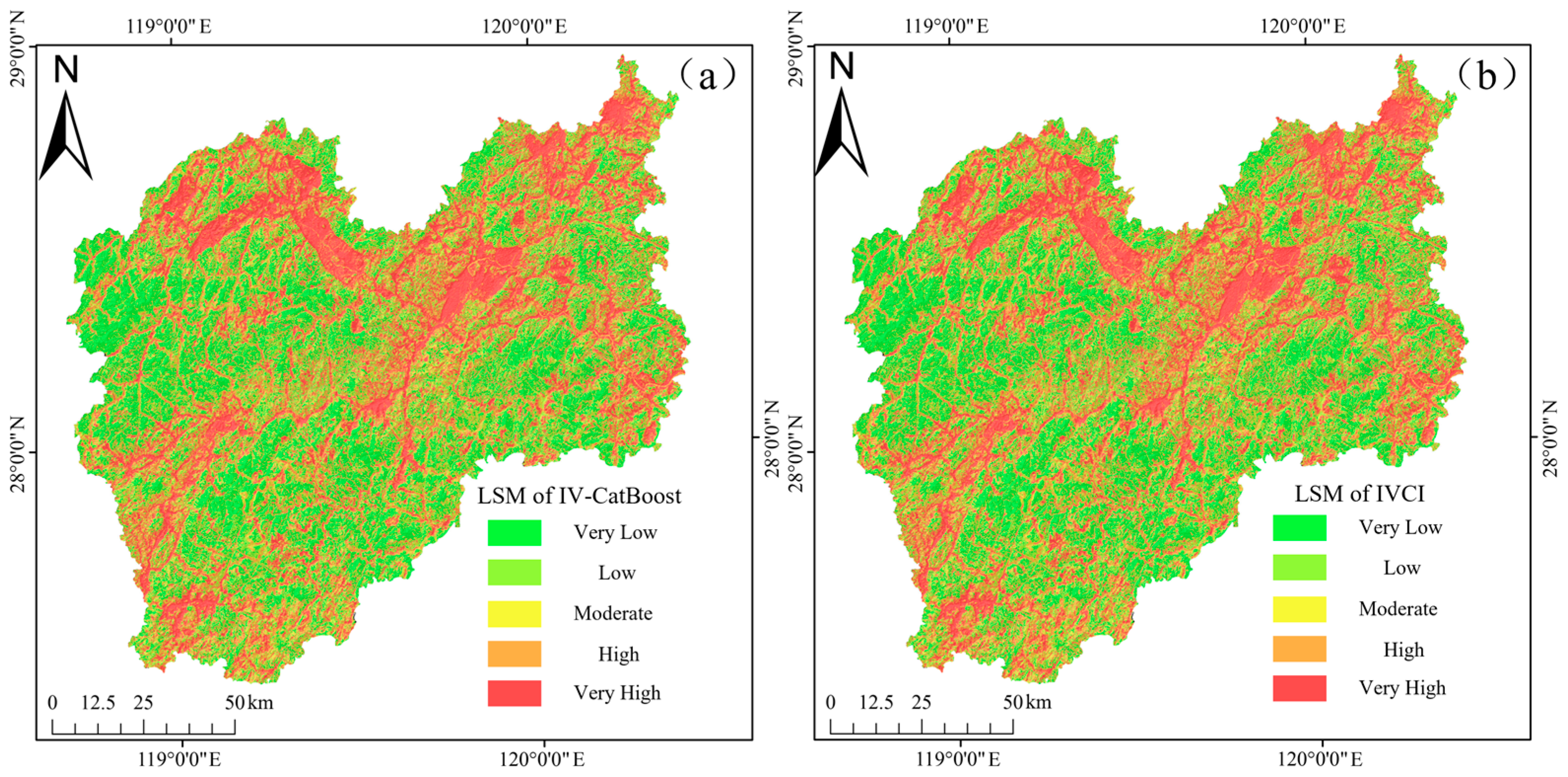
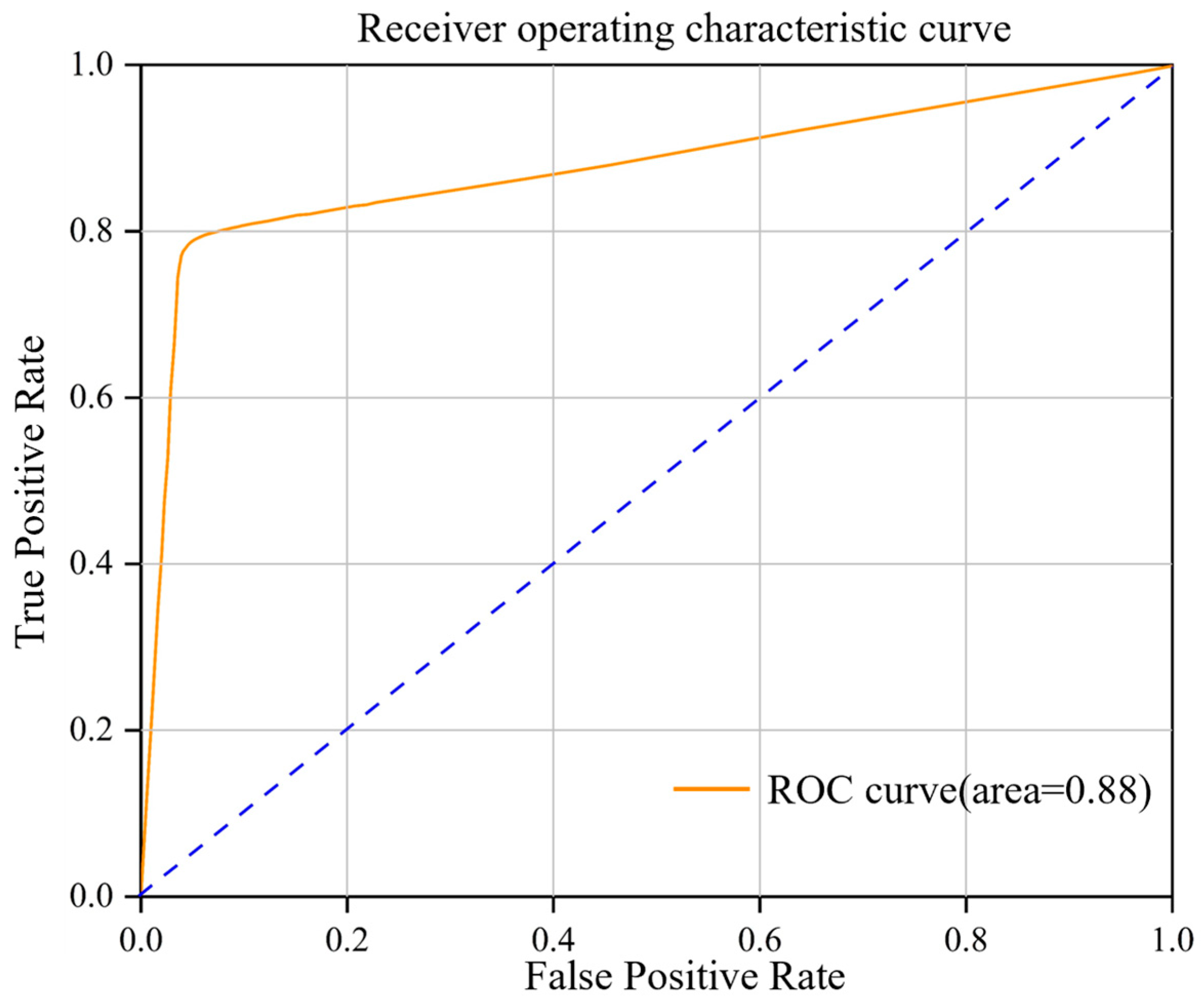
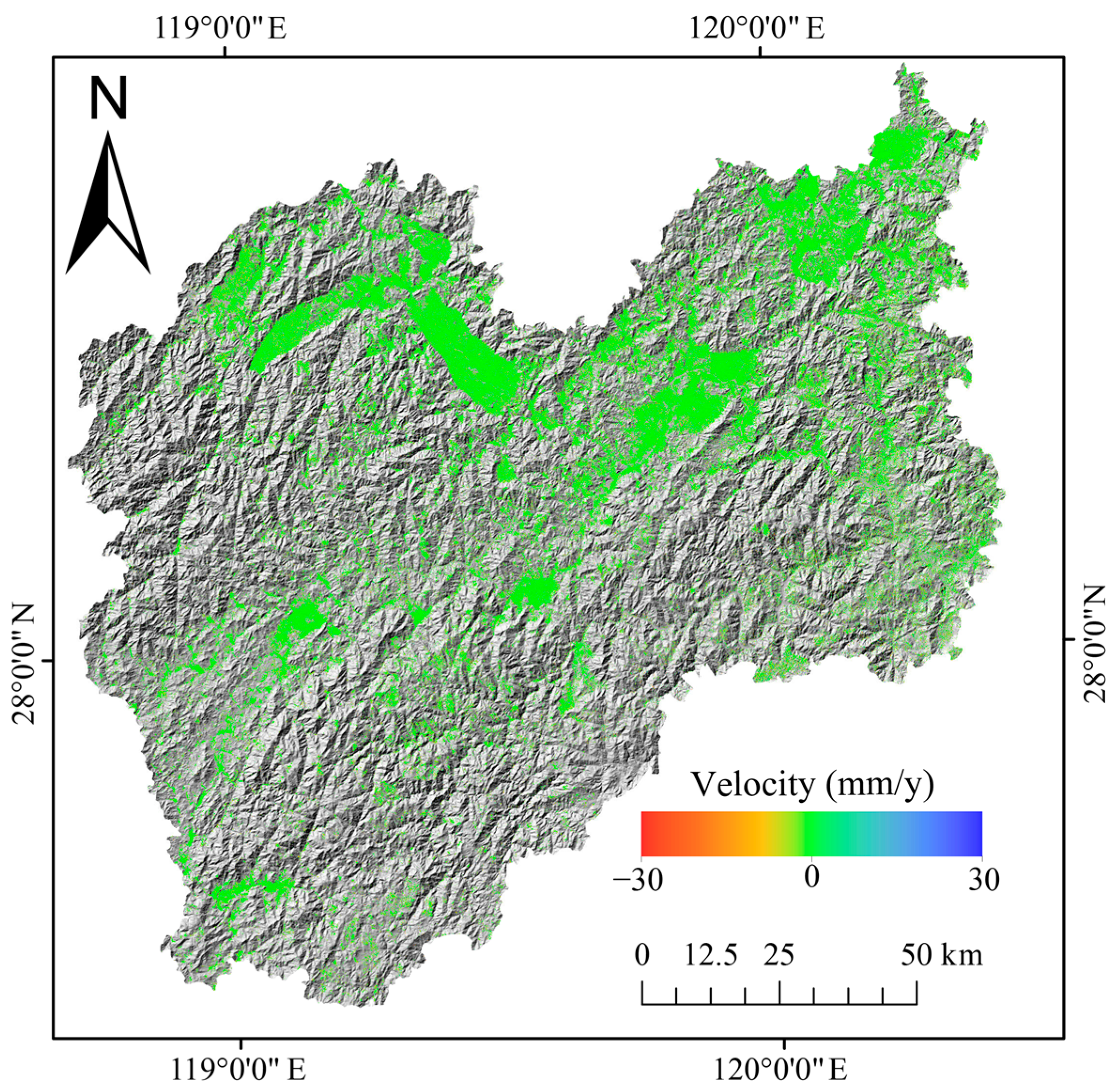
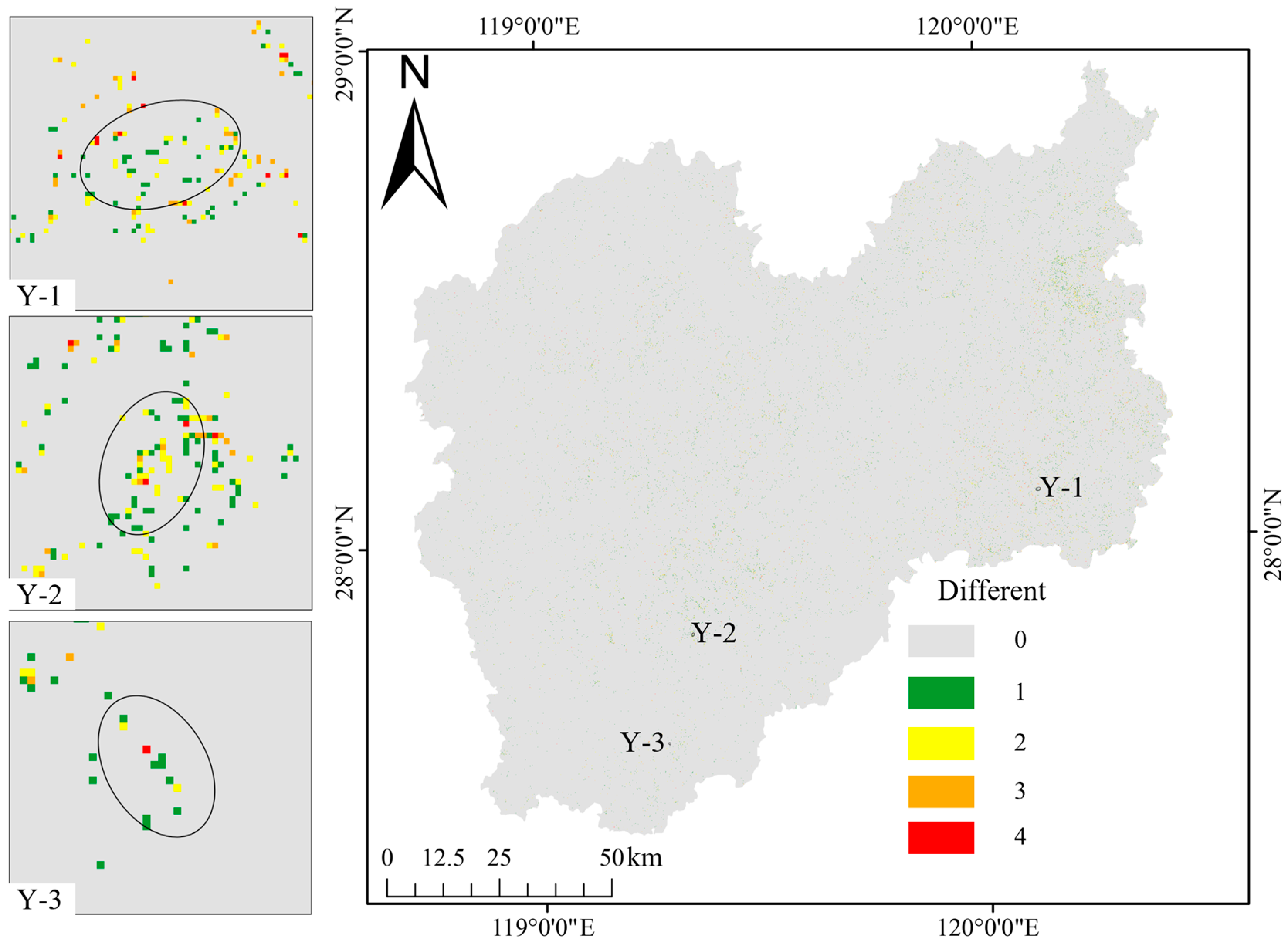
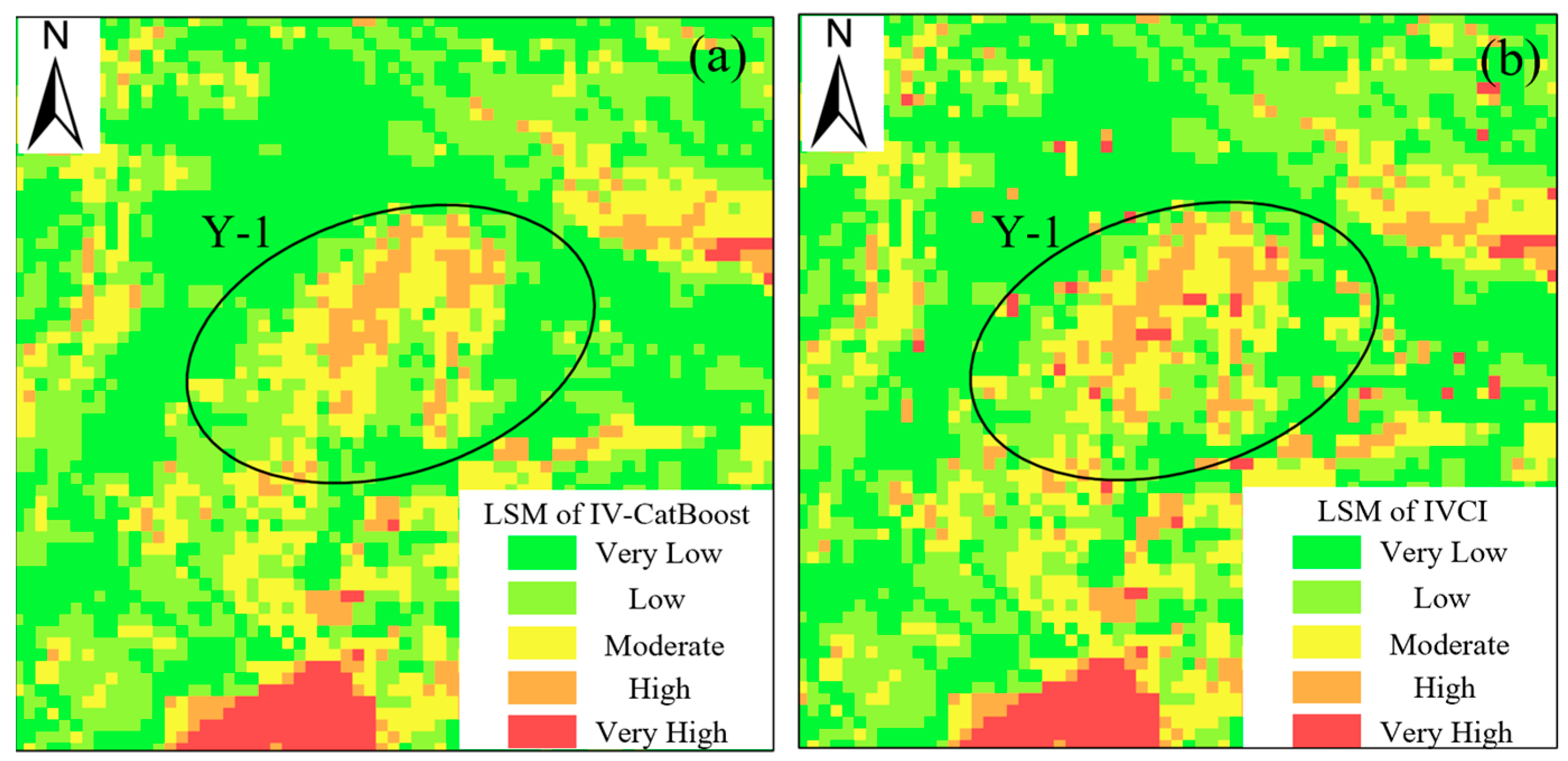
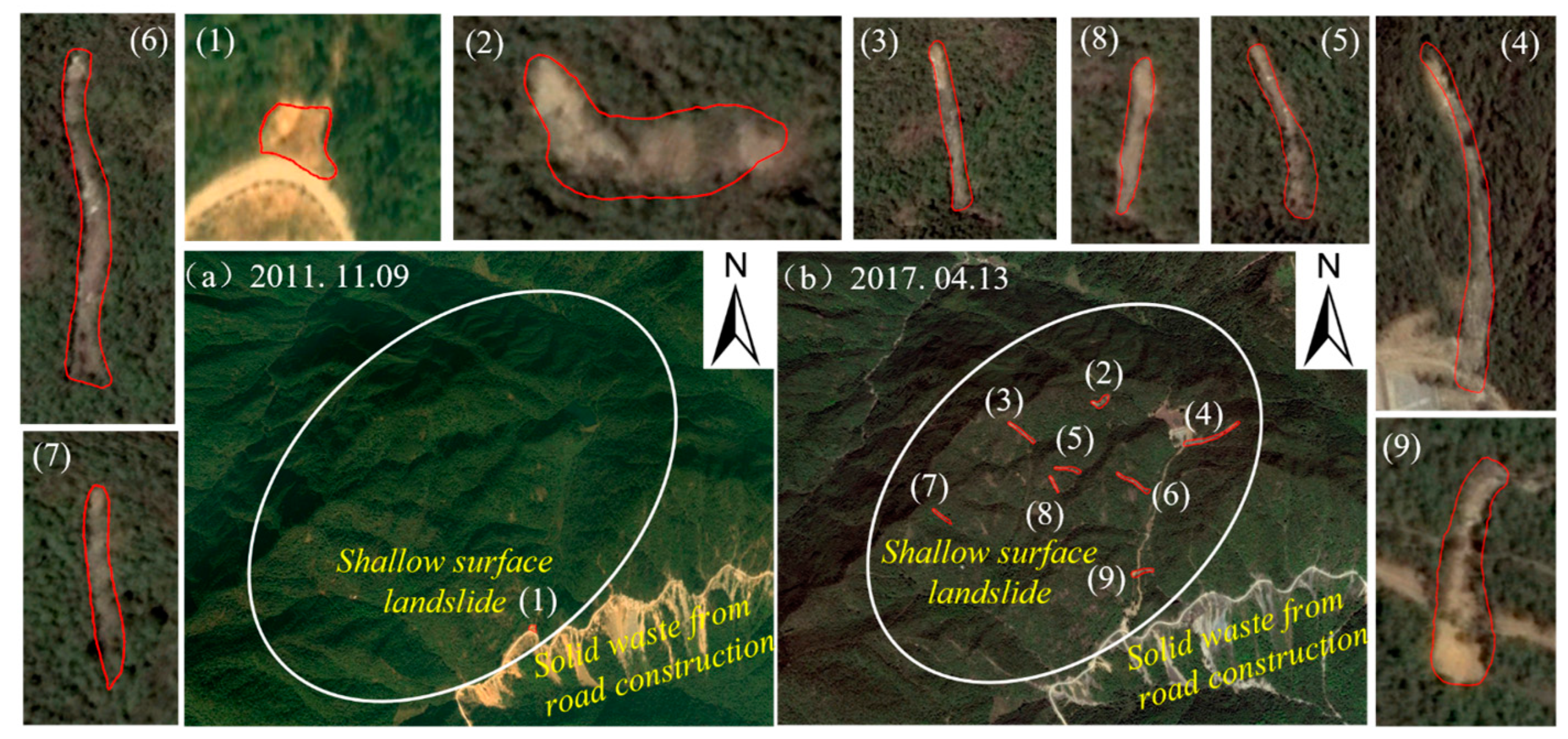

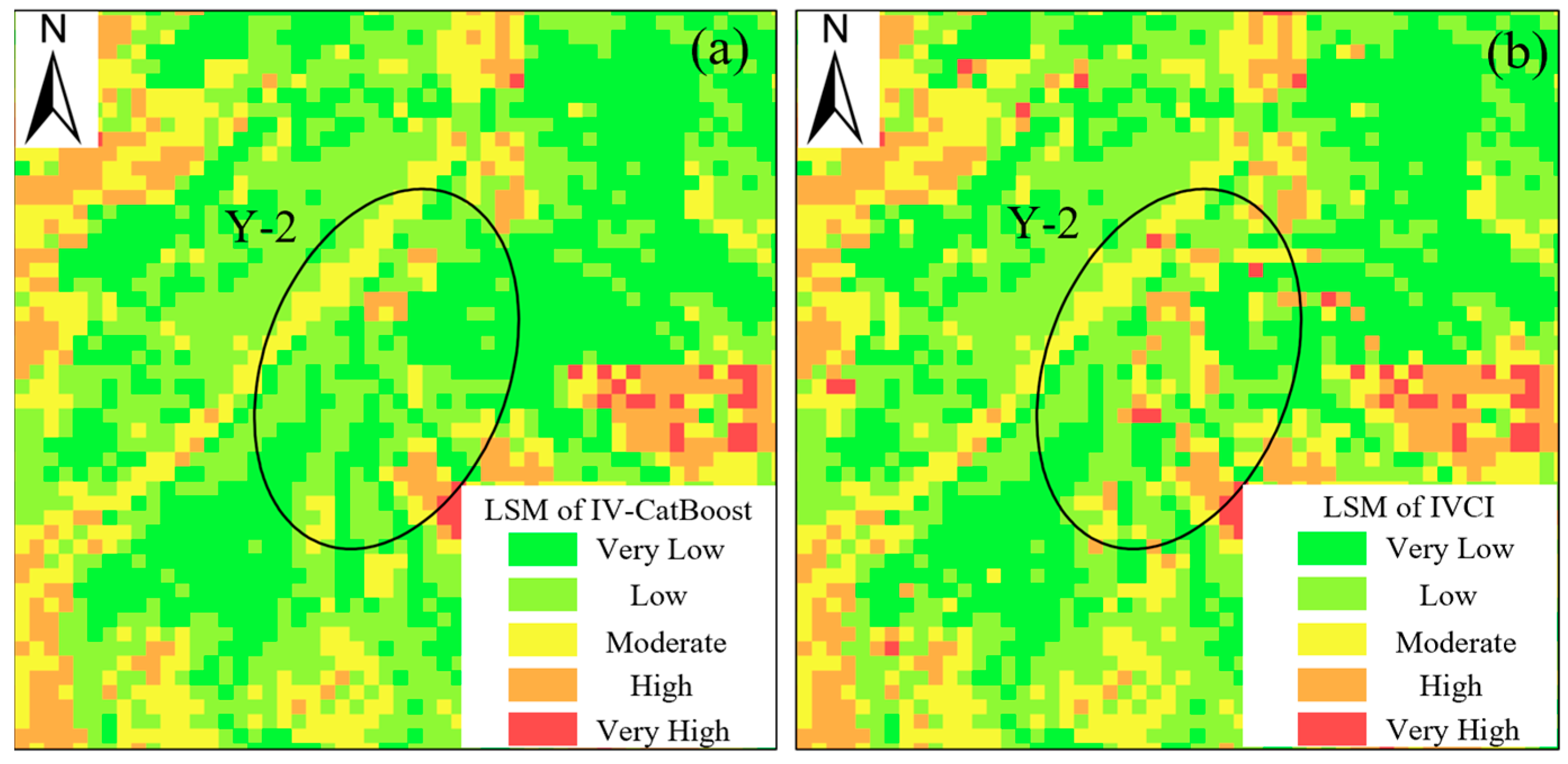
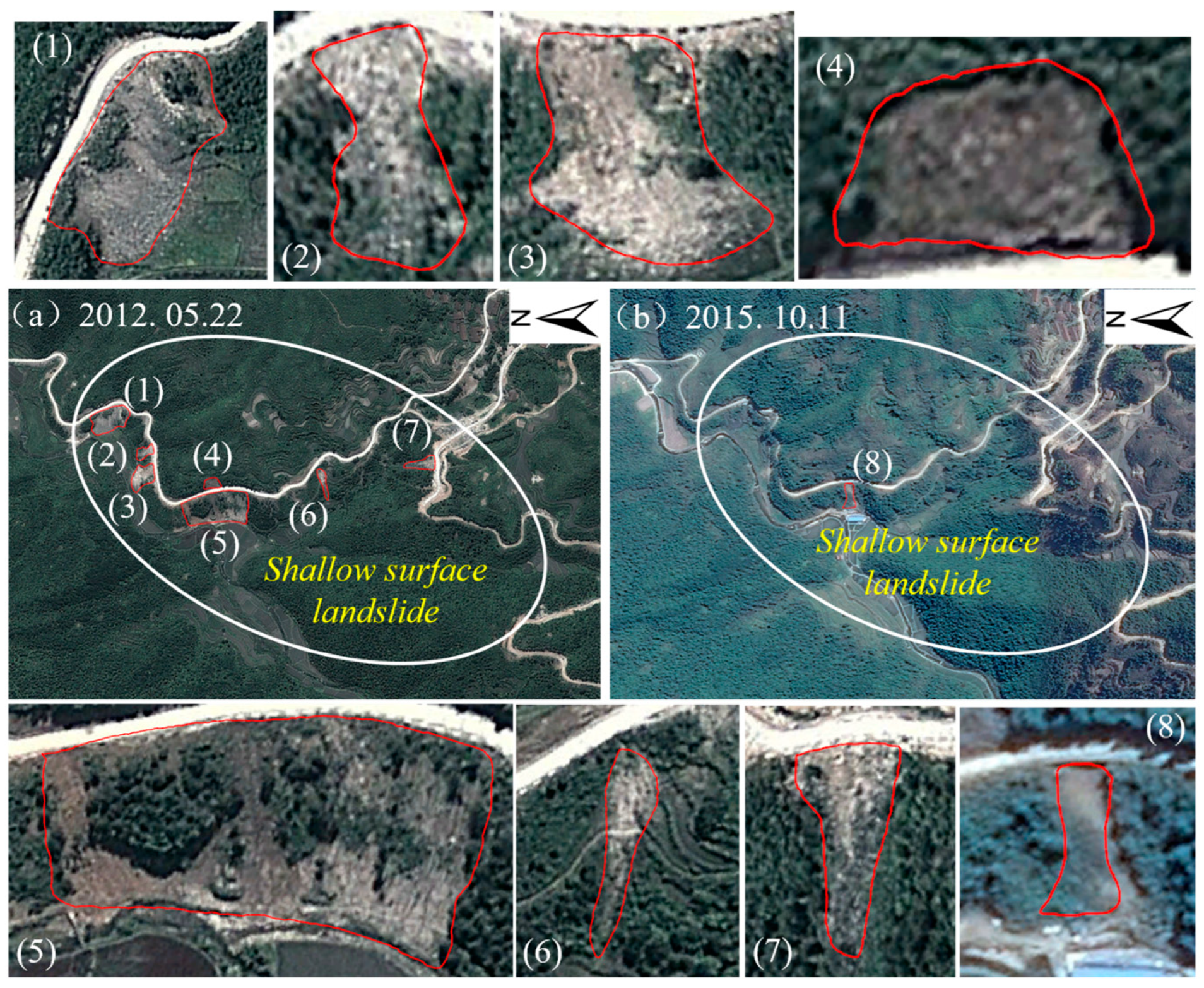
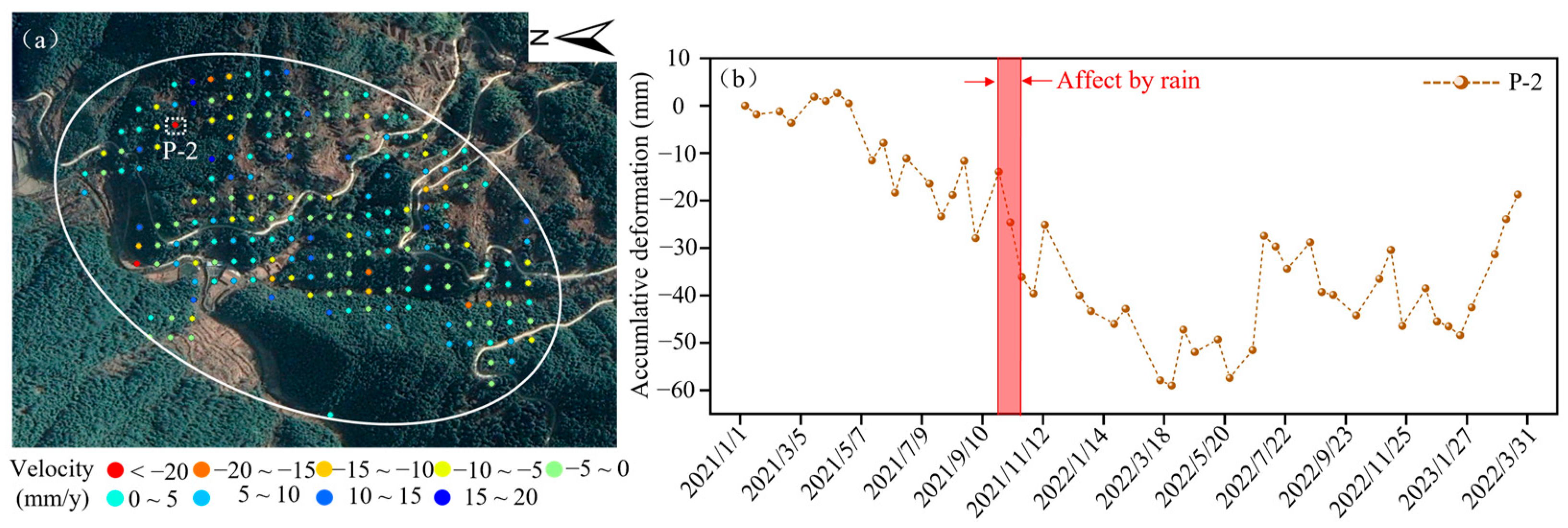
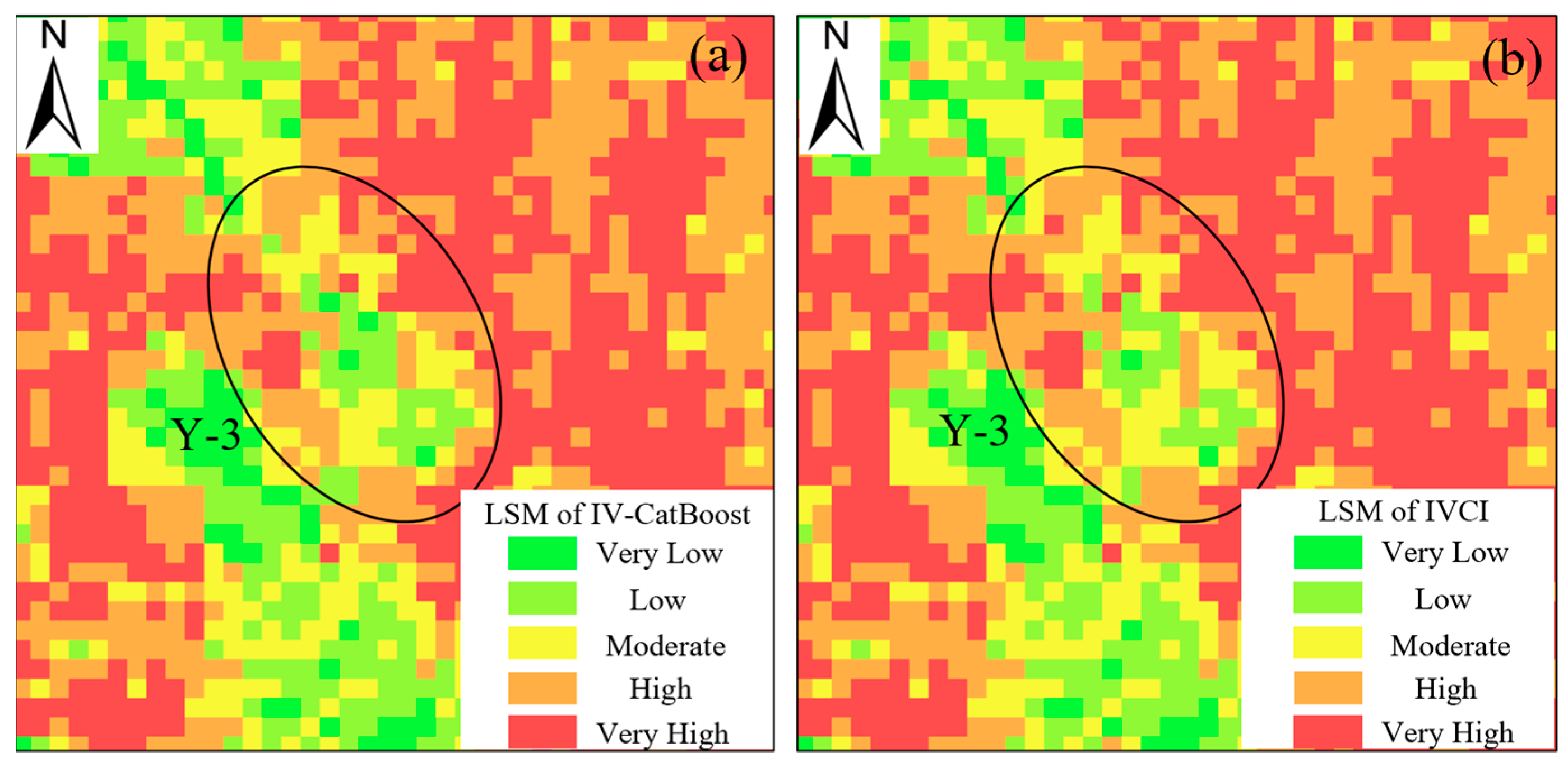
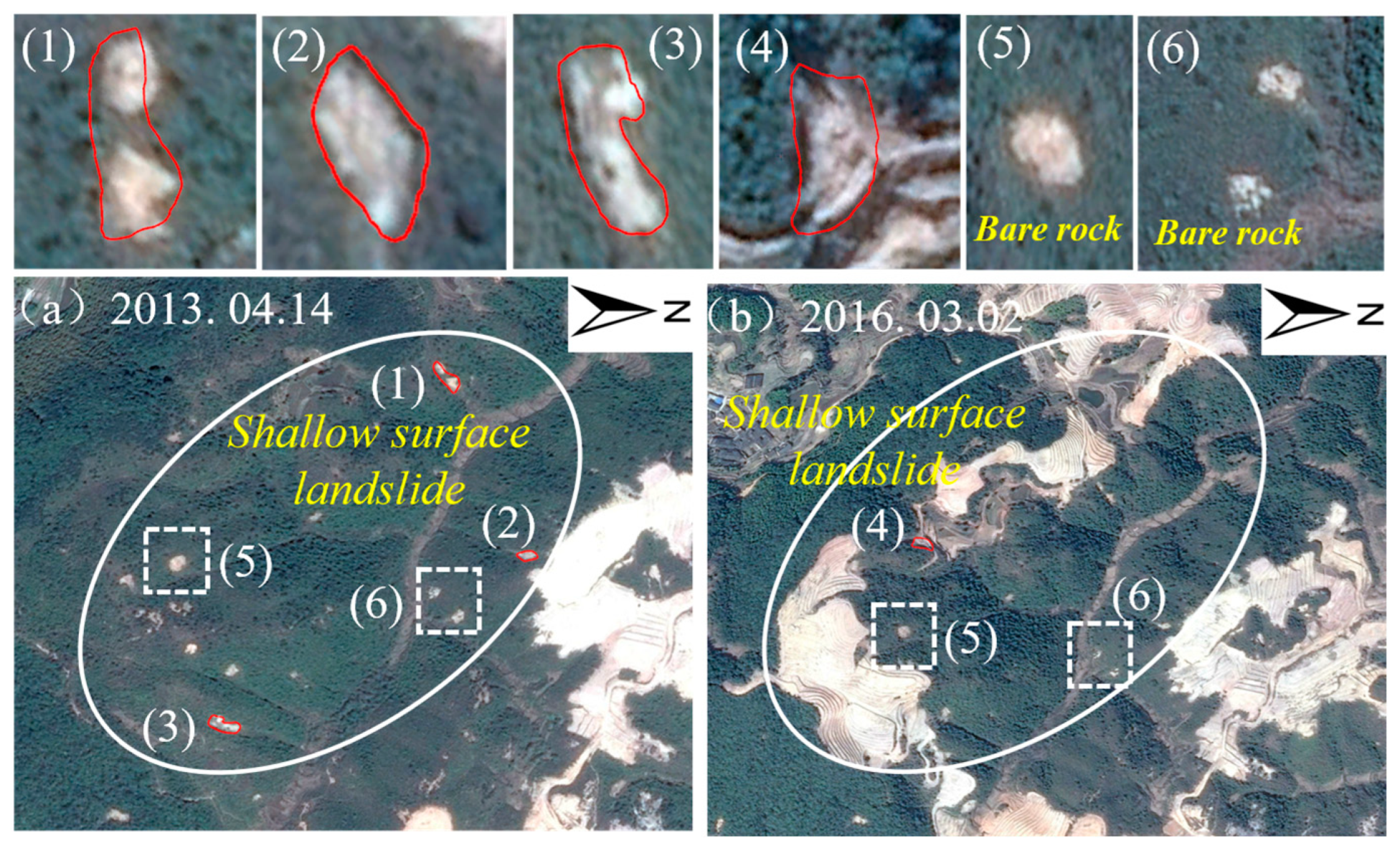

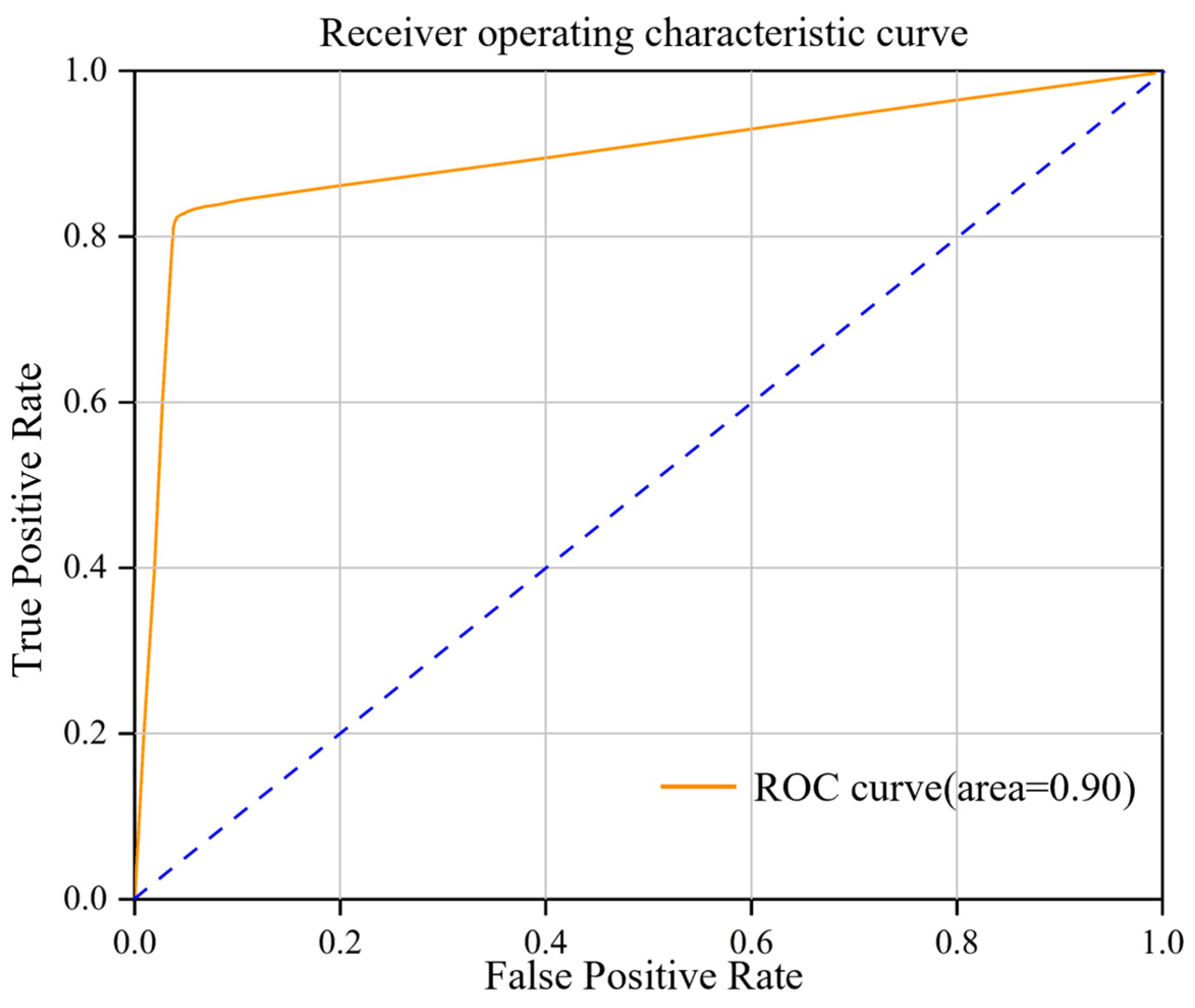
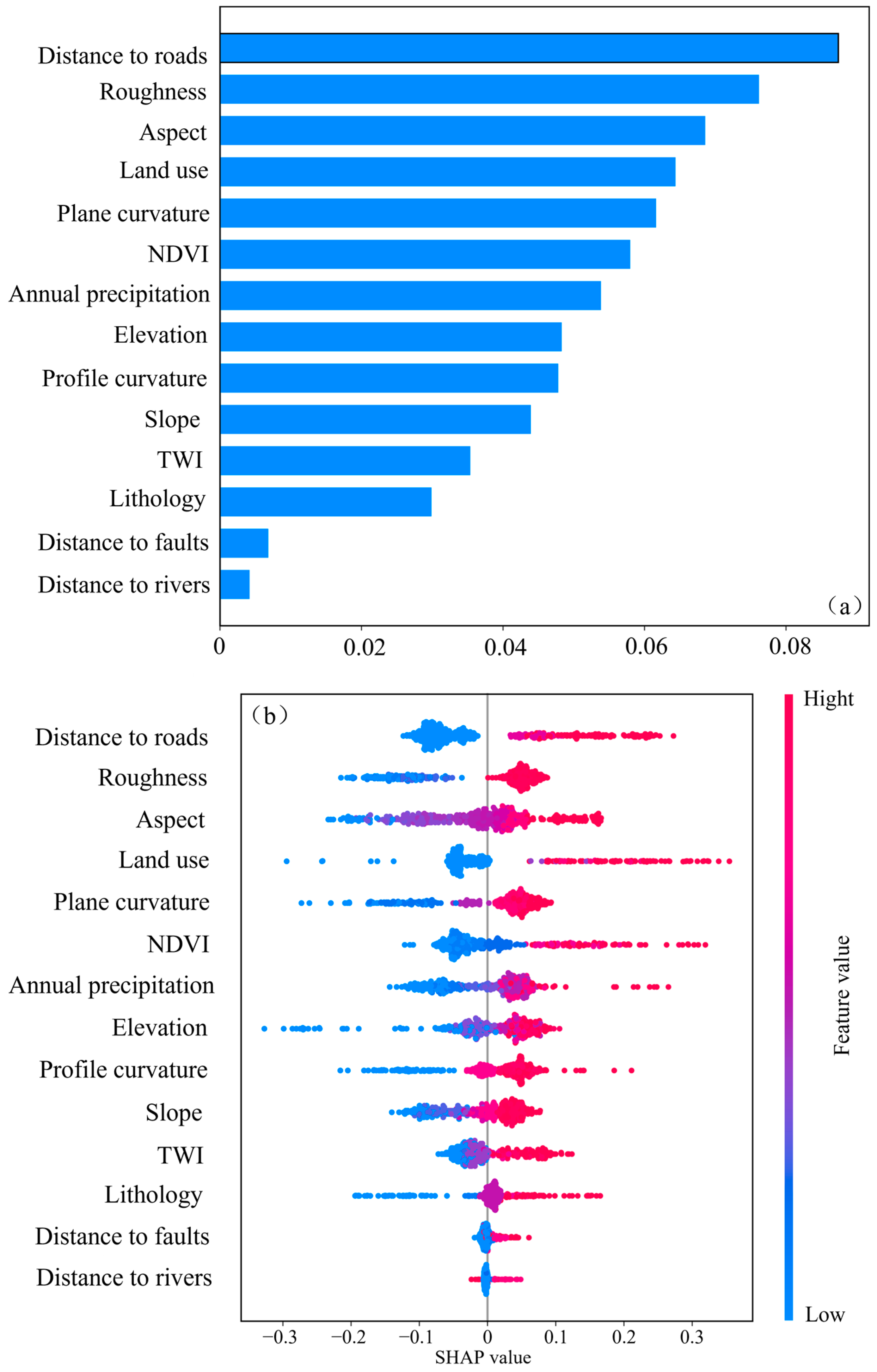
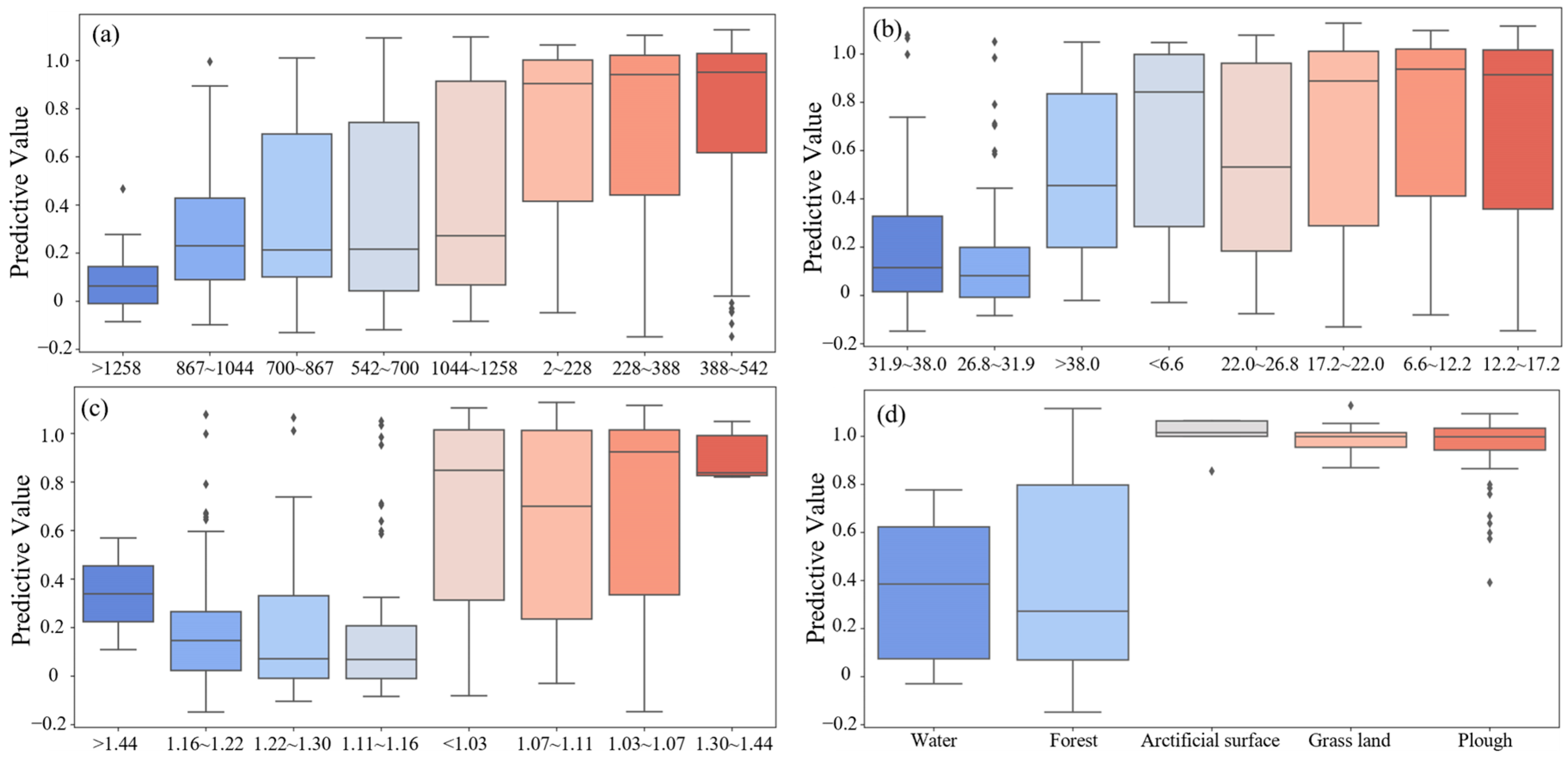
| Data Type | Source | File Type | Resolution/Scale |
|---|---|---|---|
| Terrain data | China GSCloud ASTER GDEM 30 m (https://www.gscloud.cn (accessed on 1 April 2023)) | Raster | 30 m |
| Geological data | China National Geological Archives (http://www.ngac.org.cn (accessed on 4 April 2023)) | Image | 1:500,000 |
| Basic geographic information data | (open street map) OSM (https://www.openstreetmap.org (accessed on 10 April 2023)) | Polyline | |
| Environmental features | China GSCloud Landset 8 Image (https://www.gscloud.cn (accessed on 23 April 2023)) | Raster | 30 m |
| Globe Land 30 (http://www.globallandcover.com/home.html?type=data (accessed on 3 May 2023)) | Raster | 30 m |
| Impact Factor | Type of Data | Class | Number Classified | Information Value |
|---|---|---|---|---|
| Elevation (m) | Continuous Data | <228 | 2,278,531 | 0.06201 |
| 228~388 | 3,191,332 | 0.38988 | ||
| 388~542 | 3,274,549 | 0.49857 | ||
| 542~700 | 3,040,129 | −0.32939 | ||
| 700~867 | 2,719,978 | −0.39579 | ||
| 867~1044 | 2,347,371 | −0.80346 | ||
| 1044~1258 | 1,734,651 | −0.11725 | ||
| >1258 | 621,414 | −2.21525 | ||
| Slope (°) | Continuous Data | <6.55 | 1,877,008 | −0.12175 |
| 6.55~12.15 | 2,406,548 | 0.26512 | ||
| 12.15~17.20 | 2,940,899 | 0.27359 | ||
| 17.20~22.00 | 3,193,375 | 0.22571 | ||
| 22.00~26.77 | 3,167,309 | 0.01710 | ||
| 26.77~31.85 | 2,797,168 | −0.45169 | ||
| 31.85~38.01 | 2,014,337 | −0.71689 | ||
| >38.01 | 782,341 | −0.33507 | ||
| Profile Curvature (°) | Continuous Data | <−0.99 | 75,410 | 0 |
| −0.99~−0.56 | 531,012 | −1.36489 | ||
| −0.56~−0.30 | 1,815,337 | −0.82342 | ||
| −0.30~−0.09 | 4,129,618 | −0.10186 | ||
| −0.09~0.07 | 4,676,975 | 0.10363 | ||
| 0.07~0.34 | 5,811,318 | 0.17171 | ||
| 0.34~0.71 | 1,849,367 | 0.07003 | ||
| >0.71 | 318,918 | 0.39773 | ||
| Plane Curvature (°) | Continuous Data | <−0.81 | 145,796 | −0.76546 |
| −0.81~−0.49 | 732,978 | −0.77093 | ||
| −0.49~−0.25 | 2,163,078 | −0.27412 | ||
| −0.25~−0.04 | 4,718,901 | 0.13632 | ||
| −0.04~0.12 | 5,078,221 | 0.24054 | ||
| 0.12~0.32 | 3,728,005 | 0.07489 | ||
| 0.32~0.64 | 2,157,747 | −0.59787 | ||
| >0.64 | 483,229 | −1.74060 | ||
| Roughness | Continuous Data | <1.03 | 5,377,703 | 0.13749 |
| 1.03~1.07 | 4,269,631 | 0.17292 | ||
| 1.07~1.11 | 3,467,593 | 0.15457 | ||
| 1.11~1.16 | 2,655,873 | −0.48079 | ||
| 1.16~1.22 | 1,839,959 | −0.70155 | ||
| 1.22~1.30 | 1,061,942 | −0.60389 | ||
| 1.30~1.44 | 42,885 | 2.04582 | ||
| >1.44 | 77,399 | −0.84721 | ||
| TWI * | Continuous Data | <4.72 | 5,047,898 | −0.41458 |
| 4.72~5.99 | 6,735,945 | −0.10016 | ||
| 5.99~7.48 | 4,335,641 | 0.35422 | ||
| 7.48~9.54 | 1,560,640 | 0.28828 | ||
| 9.54~12.41 | 594,284 | −0.22621 | ||
| 12.41~15.97 | 255,777 | 0.05723 | ||
| 15.97~21.13 | 587,706 | 0.11628 | ||
| >21.13 | 61,094 | 0.32597 | ||
| NDVI * | Continuous Data | <−0.26 | 166,420 | −1.59091 |
| −0.26~0 | 251,407 | 1.23521 | ||
| 0~0.17 | 384,950 | 1.59584 | ||
| 0.17~0.33 | 574,193 | 1.31377 | ||
| 0.33~0.45 | 1,176,441 | 0.75064 | ||
| 0.45~0.54 | 3,170,522 | −0.11921 | ||
| 0.54~0.61 | 6,417,901 | −0.30518 | ||
| >0.61 | 7,066,170 | −0.51115 | ||
| Aspect | Discrete Data | Flat | 21,604 | 0 |
| North | 1,125,411 | −1.15356 | ||
| East north | 2,261,127 | −0.22297 | ||
| East | 2,562,512 | 0.71887 | ||
| East south | 2,576,035 | −0.05637 | ||
| South | 2,190,668 | −0.15461 | ||
| West south | 2,254,787 | 0.38001 | ||
| West | 2,526,164 | −0.45276 | ||
| West north | 2,556,362 | −0.30899 | ||
| North (>337°) | 1,104,315 | −0.54158 | ||
| Lithology | Discrete Data | Metamorphic rock | 271,429 | −0.57646 |
| Pyroclastic rock | 151,520 | 0.11188 | ||
| Carbonate rock | 131,010 | −0.65897 | ||
| Clastic rock | 97,216 | 0 | ||
| River | 128,544 | 1.06479 | ||
| Siltstone | 13,617,154 | −0.07301 | ||
| Igneous rock | 1,789,817 | −0.72803 | ||
| Intrusive rock | 3,012,789 | 0.48927 | ||
| Land use | Discrete Data | Plough | 2,684,675 | 0.85814 |
| Forest | 15,534,117 | −0.29388 | ||
| Grass land | 475,696 | 0.63739 | ||
| Shrub land | 32,132 | 0 | ||
| Wet land | 6 | 0 | ||
| Water | 209,280 | −1.12550 | ||
| Artificial surface | 299,034 | 0.17585 | ||
| Bare ground | 409 | 0 | ||
| Distance to faults (m) | Discrete Data | 0~150 | 2,012,221 | 0.17929 |
| 150~300 | 1,936,147 | −0.01950 | ||
| 300~450 | 1,814,044 | 0.12293 | ||
| >450 | 13,445,483 | −0.04526 | ||
| Distance to rivers (m) | Discrete Data | 0~150 | 823,194 | 0.80861 |
| 150~300 | 759,897 | 0.08909 | ||
| 300~450 | 718,022 | 0.63598 | ||
| >450 | 16,906,782 | −0.10819 | ||
| Distance to roads (m) | Discrete Data | 0~150 | 2,068,488 | 0.79800 |
| 150~300 | 1,529,259 | 0.81112 | ||
| 300~450 | 1,303,437 | 0.36722 | ||
| >450 | 14,306,711 | −0.43176 | ||
| Annual precipitation (mm) | Discrete Data | <1396 | 1,225,458 | −0.23757 |
| 1396~1480 | 1,983,300 | −0.44458 | ||
| 1480~1548 | 3,097,072 | 0.10051 | ||
| 1548~1617 | 4,859,072 | −0.66094 | ||
| 1617~1686 | 3,275,853 | 0.12061 | ||
| 1686~1764 | 2,801,493 | 0.49835 | ||
| 1764~1863 | 1,296,538 | −0.14734 | ||
| >1863 | 669,130 | 0.87835 |
| Landslide Susceptibility Class | Rank | InSAR Deformation Rate Class | ||||
|---|---|---|---|---|---|---|
| 1 | 2 | 3 | 4 | 5 | ||
| VL | 1 | 0 | +1 | +2 | +3 | +4 |
| L | 2 | 0 | 0 | +1 | +2 | +3 |
| M | 3 | 0 | 0 | 0 | +1 | +2 |
| H | 4 | 0 | 0 | 0 | 0 | +1 |
| VH | 5 | 0 | 0 | 0 | 0 | 0 |
| Landslide Susceptibility Classes | |||||
|---|---|---|---|---|---|
| VH | H | M | L | VL | |
| Area of zone (km2) | 4102.33 | 3022.40 | 3009.27 | 3387.04 | 3732.14 |
| Proportion (%) | 23.78% | 17.52% | 17.44% | 19.63% | 21.63% |
| Landslide ratio (%) | 74.16% | 16.55% | 6.02% | 2.21% | 1.06% |
| Landslide Susceptibility Class | IV-CatBoost | IVCI | Landslide Susceptibility Increase | |||
|---|---|---|---|---|---|---|
| Class | No. Cells | % | NO. Cells | % | Class | No. Cells |
| VL | 4,146,823 | 21.63% | 4,071,042 | 21.24% | 0 | 19,005,155 |
| L | 3,763,380 | 19.63% | 3,741,168 | 19.51% | +1 | 94,124 |
| M | 3,343,630 | 17.44% | 3,372,395 | 17.59% | +2 | 46,992 |
| H | 3,358,220 | 17.52% | 3,403,205 | 17.75% | +3 | 19,535 |
| VH | 4,558,886 | 23.78% | 4,583,129 | 23.91% | +4 | 5133 |
Disclaimer/Publisher’s Note: The statements, opinions and data contained in all publications are solely those of the individual author(s) and contributor(s) and not of MDPI and/or the editor(s). MDPI and/or the editor(s) disclaim responsibility for any injury to people or property resulting from any ideas, methods, instructions or products referred to in the content. |
© 2023 by the authors. Licensee MDPI, Basel, Switzerland. This article is an open access article distributed under the terms and conditions of the Creative Commons Attribution (CC BY) license (https://creativecommons.org/licenses/by/4.0/).
Share and Cite
Yao, Z.; Chen, M.; Zhan, J.; Zhuang, J.; Sun, Y.; Yu, Q.; Yu, Z. Refined Landslide Susceptibility Mapping by Integrating the SHAP-CatBoost Model and InSAR Observations: A Case Study of Lishui, Southern China. Appl. Sci. 2023, 13, 12817. https://doi.org/10.3390/app132312817
Yao Z, Chen M, Zhan J, Zhuang J, Sun Y, Yu Q, Yu Z. Refined Landslide Susceptibility Mapping by Integrating the SHAP-CatBoost Model and InSAR Observations: A Case Study of Lishui, Southern China. Applied Sciences. 2023; 13(23):12817. https://doi.org/10.3390/app132312817
Chicago/Turabian StyleYao, Zhaowei, Meihong Chen, Jiewei Zhan, Jianqi Zhuang, Yuemin Sun, Qingbo Yu, and Zhaoyue Yu. 2023. "Refined Landslide Susceptibility Mapping by Integrating the SHAP-CatBoost Model and InSAR Observations: A Case Study of Lishui, Southern China" Applied Sciences 13, no. 23: 12817. https://doi.org/10.3390/app132312817
APA StyleYao, Z., Chen, M., Zhan, J., Zhuang, J., Sun, Y., Yu, Q., & Yu, Z. (2023). Refined Landslide Susceptibility Mapping by Integrating the SHAP-CatBoost Model and InSAR Observations: A Case Study of Lishui, Southern China. Applied Sciences, 13(23), 12817. https://doi.org/10.3390/app132312817







